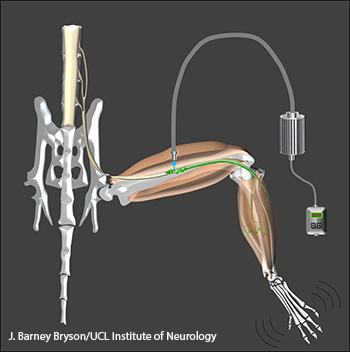
Restoration of isometric muscle function using optical stimulation of engrafted ChR2 motor neurons in vivo. EB, embryoid body.
A team of neuroscientists from University College London (UCL) and King’s College London has achieved restoration of motor function to paralyzed muscles via optical stimulation in mice in combination with transplantation of stem-cell-derived motor neurons (Science, DOI:10.1126/science.1248523). The proof-of-concept study may someday contribute to the regaining of muscle function in conditions where nerves have been damaged, such as in traumatic injury or neurodegenerative disease.
UCL professor Linda Greensmith and colleagues generated murine embryonic stem-cell-derived motor neurons that express a light-sensitive protein called channelrhodopsin-2 (ChR2), which enables their activity to be controlled by blue-wavelength light. Consequently, these ChR2 motor neurons can control movement of specific muscles in response to blue light.
The group transplanted the ChR2 motor neurons into injured branches of the sciatic nerve in mice. They then stimulated the exposed sciatic nerve with short-duration (14 ms) pulses of 470-nm blue light from a light-emitting diode via a fiber-optic light guide. The light successfully induced twitch contractions in the hind legs of mice. Illumination at a higher frequency of 40 to 80 Hz induced reproducible normal muscle contraction of specific hind leg muscles.
“This optical technique has advantages over existing techniques that use electrical stimulation, which can be painful when used to stimulate nerves,” says first author and UCL postdoctoral researcher J. Barney Bryson. “We hope we can move into human trials within the next five years or so.”
The strategy may someday lead to a way to reinnervate muscles and restore function in patients with high-level spinal cord injury or amyotrophic lateral sclerosis (ALS), also known as Lou Gehrig’s disease.
